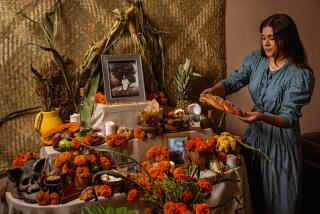L.A.’s shrines to the Virgen de Guadalupe
Every Friday, Margarita Jimenez comes to see the virgin in the parking lot, where kids scream, cars honk and the air stinks of exhaust.
She turns to the scene of chaos and asks: “Anyone want to pray with me?”
No one responds, but she pulls out her rosary beads, bows her head and begins. She knows that in the City of Angels, others share her devotion.
Catholics have long created their own sacred spaces here. They build altars in parking lots, chapels in shopping malls, grottos in back alleys and shrines in weed-choked vacant lots.
The Virgen de Guadalupe was said to have appeared for the first time in the 1500s, to a poor Indian named Juan Diego on a hill near Mexico City. She is still seen today, somber, hands in prayer, draped in the red and green of Mexico’s flag.
Audio slide show: L.A.’s shrines to the Virgen de Guadalupe
All over Mexico, she anchors altars — outside police stations, in plazas and apartment building corridors, even in public restrooms. Telenovelas feature her shrine in every barrio. It’s where the heroine goes to cry when she’s in trouble.
In Los Angeles, the tributes appear as vibrant mirages in a world of asphalt and concrete. Some are impressive, with recessed lighting and hand-carved doors imported from Mexico. Others are tiny, with little more than a burned-out candle as tribute.
Proud or plain, where there’s a virgin, there’s a story.
::
The shrine where Jimenez prays is one of East L.A.’s oldest — in the parking lot of El Mercado de Los Angeles, a large swap meet at East 1st and Lorena streets.
Here, the virgin appears framed by pink and white roses in a mural at least 15 feet high. She twinkles after dark beneath strings of Christmas lights.
Forty years ago, a group of women who sold clay pots and aprons in the parking lot loved the virgin so much that they paid a painter to grace the lot’s back wall with her image.
Over time, the painted virgin took on a life of her own. People brought her flowers and candles, kissed her robe and placed photos of their loved ones at her feet. Eventually, the swap meet manager paid to make her permanent, in tile.
“Everyone respected her,” says Maria Carlton, El Mercado’s manager. “Even the gangsters.”
Each year on her feast day, Dec. 12, hundreds gather before sunrise to serenade her. When Carlton took over El Mercado in the 1980s, she went on the radio to encourage people to come.
The annual event now draws more than 5,000 believers. They celebrate the virgin for 24 hours. Bands play, children dance and shopkeepers donate countless tamales, gallons of coffee and pots of menudo.
Jimenez, 62, always attends. But her real offering is her Friday visits.
“This way,” she says. “She’ll never feel alone.”
::
In Highland Park, the little virgin was so hidden away that no one witnessed the moment of her vanishing.
“From one day to the next,” says Roderick Smith, an artist who lives high above Figueroa Street in a big, dark brown Craftsman at the top of a 100-year-old stone stairway.
Four years ago, he and his family placed the statue in a niche at the top of the stairs — to honor his 88-year-old mother-in-law, Guadalupe Handy.
The stairway is obscured by a tall, arched wall. Gang members used to hide on the steps. Syringes littered the ground.
The virgin changed everything, says Smith, who is neither Catholic nor religious.
People began dropping by to bring the virgin flowers and pay their respects. And for the first time in 30 years, Smith’s family felt safe using the steps to walk to Figueroa.
“The shrine had power,” he says. “It’s like she turned it into some sort of basilica.”
Then suddenly, last Easter, she disappeared.
Audio slide show: L.A.’s shrines to the Virgen de Guadalupe
Smith, 60, was thinking of installing a new one weeks later when two strangers rang his doorbell. They wore Virgen de Guadalupe T-shirts and had gray splatters up to their arms.
Jose Alfredo Sanchez and Jose Ortiz Sanchez, brothers who washed cars down the road, took Smith to the niche to see their gift: a shiny, new virgin fixed in a mound of wet concrete.
Now, at least once a week, the brothers sit on the steps, sip beers and commune with their virgin.
“We call them the ushers of the basilica,” Smith says.
::
Up the road about a mile, Isabelita Vasquez said she once got a direct request from the virgin.
It happened, the Highland Park dentist says, about a decade ago, as she was praying to Our Lady of Lourdes.
The virgin, she says, asked her to help spread her word. So Vasquez decided to build her a grotto in the alley behind her office, near the remote control gate.
“I knew I had to do something,” Vasquez says. “I had to build a home for the queen mother.”
Just before Sept. 11, a worker completed Vasquez’s commission, an elaborate grotto shaped like a movie-set cave. It sits at the edge of the drab alley, crowded with statues — Our Lady of Lourdes, Our Lady of Fatima, Our Lady of Guadalupe, St. Michael, St. Gabriel, cherubs, a baby Jesus, several grown-up ones.
Vasquez brought in avocado trees, orchids and bougainvillea, then wrought-iron benches so people could sit. She put up a canopy to protect her creation from rain.
Worship continues inside the dentist’s office. Her waiting room features its own small shrine, where patients sometimes pray before appointments. Every Wednesday, when the office is closed, Vasquez goes there anyway to recite the rosary. And once a month, as a special offering, she and a group of other devoted women recite 2,000 Hail Marys.
Some people don’t get it. She understands that. But she feels God is proud of her work. She points to her back door, down a dark hall, as proof. When the door is shut and you stand at a certain angle, she says, a bearded face appears.
“It is Jesus,” she says. “He is there. But if you don’t believe, you will not see him.”
::
Plaza Mexico in Lynwood goes to great lengths to be authentic. The shopping center’s façade replicates Guadalajara’s government palace and the lamps and bright colors evoke San Miguel de Allende. People from Mexico shop here because it feels like home.
So 11 years ago, when thousands wrote in and called for a chapel honoring the virgin, “it had to be the real deal,” says marketing director Carlos Villar.
That meant getting an official painting of the virgin as she appeared on Juan Diego’s apron from the place where the apron was kept, the Basilica de Guadalupe near Mexico City.
Such a request could take years. So the plaza’s staff launched a full-on campaign. They contacted the basilica’s archbishop and sent him videos, photos and documents to prove Los Angeles’ love for the virgin. To welcome her, they built a colonial-style chapel, with recessed lights in its high ceiling.
Assistant Manager Norma Rodriguez spent nearly a month in Mexico in search of the perfect doors.
Today, the holy portrait sits in a silver and gold frame, its authenticity confirmed by the archbishop’s signature.
Jairo Ramirez, 22, visits her once a week after shopping and paying his cellphone bill.
“I ask her the same thing each time,” the tapestry worker says. “‘Take care of me and take of my family in San Luis Potosi until I’m able to return home.’”
::
In Echo Park, no one seemed to mind that her shrine resembled a doghouse.
People sat before her in plastic chairs to pray — for the gangs to settle down, for the father who couldn’t find work.
Silvia Jacinto, 51, lived across the street from the shrine in its overgrown vacant lot. She felt honored to watch over it.
The virgin, who came from Tijuana, is a bit taller than a ruler. She starred in the neighborhood’s Christmas posadas, and at first she was passed from house to house. But about 2005, her worshippers decided she needed a place of her own.
Half a dozen neighborhood men set out to build it in a lot that a local arts center was transforming into a park. They used scraps of tile, stucco and shingles. Their wives brought them water and beer. The work went on for seven months.
In the end, the men beamed at their handiwork: a beige and baby-blue structure shaped just like Snoopy’s house.
Audio slide show: L.A.’s shrines to the Virgen de Guadalupe
“When I saw it I thought, ‘Oh wow. That’s not what I would have done,’” says Tricia Ward, founder of the arts center, Art … Community … Land … Activism. “But it’s their shrine, and they love it just the way it is.”
Or they did.
Some of the prayerful moved away as parts of the area gentrified. Others stopped going outside, afraid of gangs that still lingered. In the span of two years, on nearby streets, a 9-year-old was killed, then a 4-year-old.
Nowadays, the keeper of the shrine is its only regular visitor. She gently wipes dust off the virgin’s face and robes. She scrapes candle wax off the tile. And she bides her time.
“My faith is so big,” Jacinto says, “I know people one day will want to come back.”
More to Read
Sign up for Essential California
The most important California stories and recommendations in your inbox every morning.
You may occasionally receive promotional content from the Los Angeles Times.











